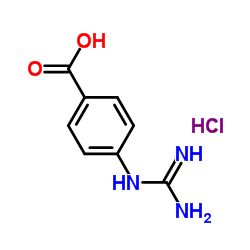N-(4-Carboxyphenyl)guanidine hydrochloride

N-(4-Carboxyphenyl)guanidine hydrochloride structure
|
Common Name | N-(4-Carboxyphenyl)guanidine hydrochloride | ||
|---|---|---|---|---|
| CAS Number | 42823-46-1 | Molecular Weight | 215.637 | |
| Density | N/A | Boiling Point | 438.4ºC at 760 mmHg | |
| Molecular Formula | C8H10ClN3O2 | Melting Point | 285 °C (dec.)(lit.) | |
| MSDS | Chinese USA | Flash Point | 218.9ºC | |
|
The specificity of murine polyclonal and monoclonal antibodies to the haptenic drug chlorhexidine induced by chlorine-generated chlorhexidine-protein conjugates.
Clin. Exp. Immunol. 69(1) , 157-65, (1987) Polyclonal and monoclonal antibodies to the antibacterial agent chlorhexidine (1,1'-hexamethylene bis [5-(p-chlorophenyl)]biguanide, mol. wt = 505) were raised using a chlorine-generated N-chloro chlorhexidine-keyhole limpet haemocyanin (NCC-KLH) conjugate as... |
|
|
Evidence for an enzyme which cleaves the guanidinobenzoate moiety from active-site titrants specifically designed to inhibit and quantify trypsin.
Eur. J. Biochem. 130(2) , 335-9, (1983)
|
|
|
Inhibition of prostasin secretion by serine protease inhibitors in the kidney.
J. Am. Soc. Nephrol. 14(1) , 11-6, (2003) A serine protease, prostasin, has been shown to stimulate the activity of amiloride-sensitive sodium channels (ENaC). Prostasin is a glycosylphosphatidylinositol-anchored protein that is found free in physiologic fluids and tissue culture medium, but the mech... |
|
|
Mechanisms of the hyperkalaemia caused by nafamostat mesilate: effects of its two metabolites on Na+ and K+ transport properties in the rabbit cortical collecting duct.
Br. J. Pharmacol. 111(1) , 173-8, (1994) 1. The present experiments were undertaken to determine the mechanism(s) of hyperkalaemia caused by nafamostat mesilate (NM), a serine-protease inhibitor. 2. We investigated the effects of luminal addition of two metabolites of NM, p-guanidinobenzoic acid (PG... |
|
|
Elimination of the low-molecular weight proteinase inhibitor camostate (FOY 305) and its degradation products by the rat liver.
Res. Exp. Med. (Berl.) 187(6) , 401-6, (1987) The elimination of the low molecular weight proteinase inhibitor camostate (FOY 305) was studied in rats after oral administration and in the the situ perfused rat liver. After feeding of camostate (400 mg/kg b.w.) only the metabolites (FOY 251, GBA) were det... |
|
|
Kinetics and mechanism for the conformational transition in p-guanidinobenzoate bovine trypsinogen induced by the isoleucine-valine dipeptide.
Biophys. Chem. 10(3-4) , 253-60, (1979) The interaction between p-guanidinobenzoate-trypsinogen and the isoleucine-valine dipeptide has been investigated by temperature-jump relaxation spectrometry. Using the absorbance at 281 nm the concentration dependence of the relaxation parameters is consiste... |
|
|
Hepatic and pancreatic metabolism and biliary excretion of the protease inhibitor camostat mesilate.
Int. J. Pancreatol. 10(3-4) , 197-205, (1991) The hepatic metabolism and biliary and pancreatic excretion of the serine protease inhibitor camostat mesilate and its metabolites FOY-251 and GBA were studied in rats in vivo and in in sutu liver-perfusion experiments. After oral feeding (100 mg/kg) and iv i... |
|
|
Additional mechanisms of nafamostat mesilate-associated hyperkalaemia.
Eur. J. Clin. Pharmacol. 51(2) , 149-51, (1996) Nafamostat mesilate, a potent protease inhibitor, is widely used for the treatment of pancreatitis, disseminated intravascular coagulation and as an anticoagulant in haemodialysis. However, hyperkalaemia associated with nafamostat mesilate has been reported. ... |
|
|
The kinetic and structural characterization of the reaction of nafamostat with bovine pancreatic trypsin.
Thromb. Res. 98(6) , 559-69, (2000) Nafamostat mesilate (FUT-175), a synthetic serine protease inhibitor, is active against a number of the serine proteases involved in coagulation. This has been proposed as the basis of its anticoagulant activity. We investigated the reaction of Nafamostat wit... |
|
|
Metabolic fate of 14C-camostat mesylate in man, rat and dog after intravenous administration.
Xenobiotica 24(1) , 79-92, (1994) 1. The metabolic fate of N,N-dimethylcarbamoylmethyl 4-(4-guanidino[14C]benzoyloxy)phenylacetate methanesulphonate (14C-camostat mesylate) was investigated after i.v. administration to man (12-h infusion), and to rat and dog (bolus injection). 2. Renal excret... |